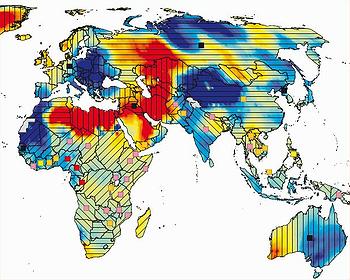世界衛生組織(WHO)及世界氣象組織(WMO)共同發表報告《圖解健康與氣候》(Atlas of Health and Climate)」,點出了目前最緊迫的問題及挑戰。這兩個聯合國高階機構警告:氣候變遷不只帶來更多的極端氣候如颶風、洪水及乾,對人類健康的危害也在增加。
Image may be NSFW.
Clik here to view.
《圖解健康與氣候》以實際的案例顯示如何使用氣象及氣候的資料來保護人類健康。這份報告的發表為國際公眾健康及氣象組織間的合作開啟新的里程碑。
世界氣象組織秘書長賈侯(Michel Jarraud)表示,「這份圖解是創新且實用的案例,說明我們可以共同合作來服務社會。」
這份報告在日內瓦舉辦為期三天的世界氣象大會29日開幕式中提出,世界氣象組織的183個會員國代表在本次會議將討論全球思維下氣候服務草案架構及落實方式。
WMO期為聯合國各國全民福祉加強提供氣候服務,尤其在四個優先項目上:健康、食品安全、水資源管理和降低災害風險。
颶風,暴風,水災和乾旱每年影響數百萬人。極端氣候變化(如水災)會引發腹瀉、瘧疾、登革熱和腦膜炎等疾病,這些疾病將導致百萬人的痛苦及死亡。
世界衛生組織執行長馮富珍指出,「公共衛生的中心思想是預防及準備;我們每天都在處理風險管理。氣候變動及改變的資訊可以成為協助我們處理這些任務的有力科學工具。」「氣候對地球上的生物及人類的生存產生極大的影響;氣候服務可以透過包含健康衛生環境的改善等方式來改善生活。」
Image may be NSFW.
Clik here to view.
舉例來說,報告中呈現了2010年那些衛生條件差及供水貧瘠的國家,不尋常的降雨與霍亂在地圖上的覆蓋範圍,呈現出需要未來研究及給予衛生支援的區域。
馮富珍與賈侯都認為,目前為止在公眾健康議題上,氣候服務仍是一個未被充分使用的資源。但這些服務是有用的。在這份「圖說」中的案例研究闡釋結合氣象、緊急事故及公眾健康服務可以用來拯救生命。
舉例說明,由於預警系統的改善及充足的準備,孟加拉死於暴風的人數,由1970年的50萬人、1991年的14萬人到2007年降至3000人。
賈侯說明,「在氣象及社區健康間建立緊密的合作,可確保國際、國家及地區層級的公眾健康管理獲得最新、準確的氣象及氣候資訊。」
該報告陳述,目前認為每20年才會發生一次的極端熱浪,到了本世紀中可能會每2-5年發生一次。同時,全球居住在都市中的老年人口數,到了2050年將自2010年的3.8億人成長4倍到14億人。在熱浪來襲時,結合公眾健康與氣候服務,可給予脆弱的高齡族群更好的保護防禦機制來適應極端氣候。「轉換家庭能源為乾淨能源除了可以降低氣候變遷,每年還可因為改善空氣污染拯救68萬個孩童的性命。」
這份圖解也呈現氣象和衛生服務間的合作,可監測空氣污染及其對健康的影響。
在這份研究中的地圖、表格及圖表清楚呈現了公眾健康及氣候間的連結。在某些地區像是瘧疾、登革熱、腦膜炎和霍亂這些取決於天氣與氣候狀況的傳染病,在不同季節間可能受到超過100種因素影響、不同年間變異也很大。
馮富珍與賈侯共同表示,在這些疾病盛行的國家,氣候服務有助於預測疾病爆發、強度和持續時間。
這份獨特的圖解也呈現受到其他因素,如貧困、環境惡化、貧乏的水及衛生基礎設施影響下,公眾健康與氣候的關連性。
As the changing climate brings more extreme weather – hurricanes, floods and drought – human health hazards are increasing, warn the world’s top health and weather officials. The “Atlas of Health and Climate,” published today jointly by the World Health Organization and the World Meteorological Organization, pinpoints the most pressing current and emerging challenges.
The “Atlas of Health and Climate” gives practical examples of how the use of weather and climate information can protect public health. Its publication today marks a new collaboration between the international public health and meteorological communities.
“This Atlas is an innovative and practical example of how we can work together to serve society,” said Michel Jarraud, secretary-general of the World Meteorological Organization, WMO.
The Atlas was released at a three-day Extraordinary Session of the World Meteorological Congress that opened today in Geneva. Here, delegates from the WMO’s 183 member governments will discuss the structure and implementation of the draft Global Framework for Climate Services.
A United Nations-wide initiative spearheaded by WMO to strengthen the provision of climate services to the benefit of society, especially the most vulnerable, the framework focuses on top four priorities – health, food security, water management and disaster risk reduction.
Hurricanes, cyclones, floods and drought affect the health of millions of people each year. Climate variability and extreme conditions such as floods can trigger disease epidemics – diarrhea, malaria, dengue and meningitis – which cause death and suffering for millions more.
“Prevention and preparedness are the heart of public health. Risk management is our daily bread and butter. Information on climate variability and climate change is a powerful scientific tool that assists us in these tasks,” said Dr. Margaret Chan, director-general of the World Health Organization, WHO.
“Climate has a profound impact on the lives, and survival, of people,” said Dr. Chan. “Climate services can have a profound impact on improving these lives, also through better health outcomes.”
For instance, the Atlas shows how information on unusual rainfall events, overlaid on a map with 2010 reported cholera cases from the countries where access to water and sanitation remains poor, indicate priority areas for further research and health intervention.
Until now, Chan and Jarraud agree, climate services have been an underutilized resource for public health. But where these services have been utilized they have been effective. Case studies in the new Atlas illustrate how collaboration between meteorological, emergency and health services is already saving lives.
For example, the death toll from cyclones of similar intensity in Bangladesh has been reduced from around 500,000 in 1970, to 140,000 in 1991, to 3,000 in 2007, due to improved early warning systems and preparedness.
“Stronger cooperation between the meteorological and health communities is essential to ensure that up-to-date, accurate and relevant information on weather and climate is integrated into public health management at international, national and local levels,” said Jarraud.
Heat extremes now expected to occur only once in 20 years, may occur every two to five years by the middle of this century, the officials project.
At the same time, the number of older people living in cities will almost quadruple globally, from 380 million in 2010, to 1.4 billion in 2050. Cooperation between health and climate services can create measures to better protect people in this vulnerable group from heat stress during periods of extreme weather.
“Shifting to clean household energy sources would both reduce climate change, and save the lives of some 680,000 children a year from reduced air pollution,” they said.
The Atlas also shows how meteorological and health services can collaborate to monitor air pollution and its health impacts.
Maps, tables and graphs assembled in the Atlas make the links between health and climate clear. In some locations the incidence of infectious diseases such as malaria, dengue, meningitis and cholera can vary by factors of more than 100 between seasons, and can vary greatly between years, depending on weather and climate conditions.
Stronger climate services in countries where these diseases are endemic can help predict the onset, intensity and duration of outbreaks, said Jarreau and Chan.
The unique Atlas also shows how the relationship between health and climate is shaped by other vulnerabilities, such as those created by poverty, environmental degradation, and poor infrastructure, especially for water and sanitation.
※ 全文及圖片詳見:ENS